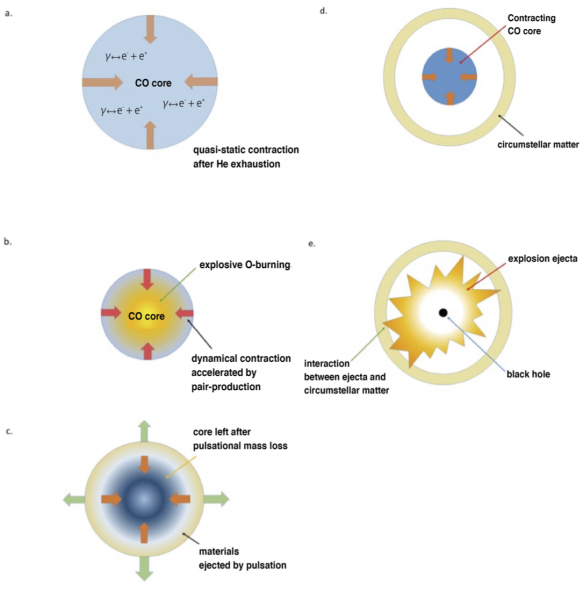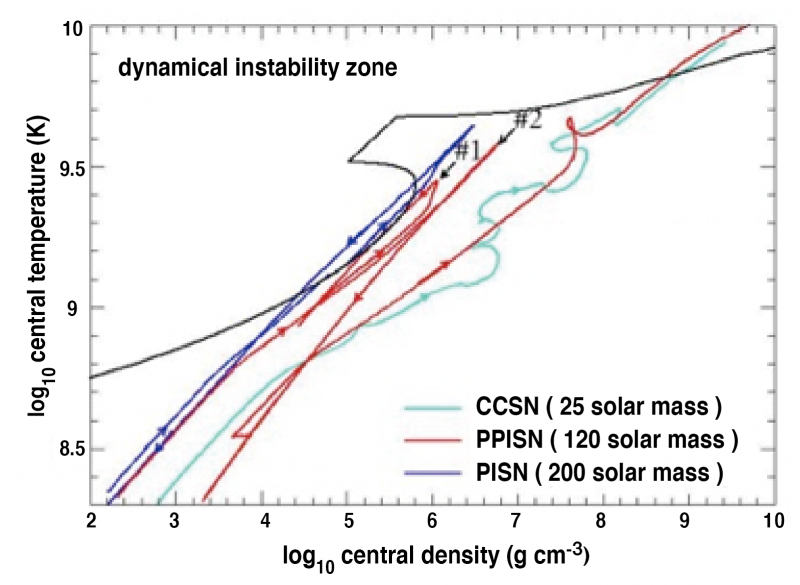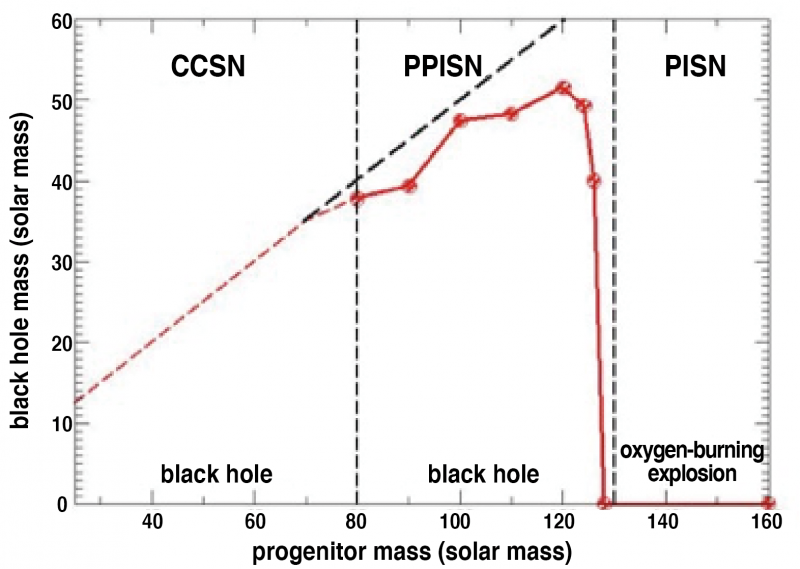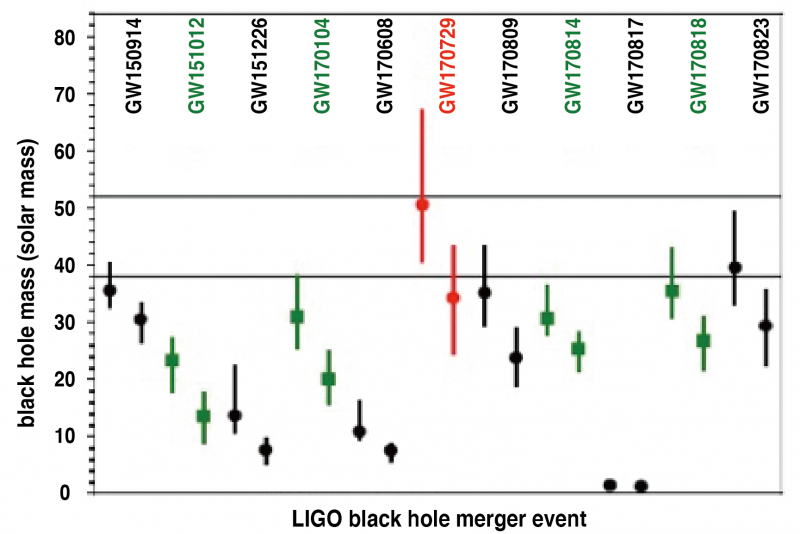6.07.2020
Through simulations of a dying star, a team of theoretical physics researchers have found the evolutionary origin and the maximum mass of black holes which are discovered by the detection of gravitational waves as shown in Figure 1.
The exciting detection of gravitational waves with LIGO (laser interferometer gravitational-wave observatory) and VIRGO (Virgo interferometric gravitational-wave antenna) have shown the presence of merging black holes in close binary systems.
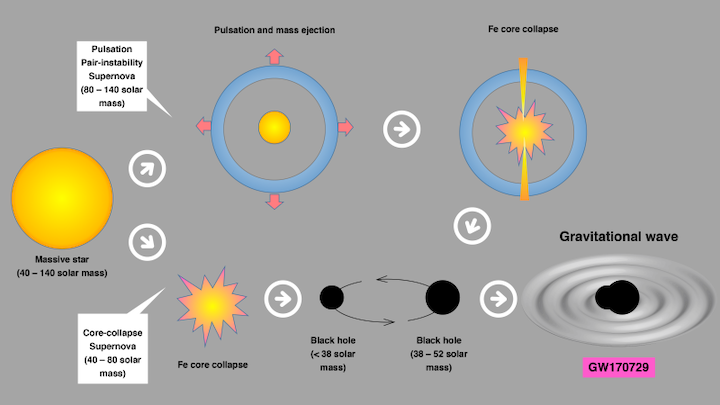
Figure 1: Schematic diagram of the binary black hole formation path for GW170729. A star below 80 solar mass evolves and develops into a core-collapse supernova. The star does not experience pair-instability, so there is no significant mass ejection by pulsation. After the star forms a massive iron core, it collapses by its own gravity and forms a black hole with a mass below 38 solar mass. A star between 80 and 140 solar mass evolves and develops into a pulsational pair-instability supernova. After the star forms a massive carbon-oxygen core, the core experiences catastrophic electron-positron pair-creation. This excites strong pulsation and partial ejection of the stellar materials. The ejected materials form the circumstellar matter surrounding the star. After that, the star continues to evolve and forms a massive iron core, which collapses in a fashion similar to the ordinary core-collapse supernova, but with a higher final black hole mass between 38 - 52 solar mass. These two paths could explain the origin of the detected binary black hole masses of the gravitational wave event GW170729. (Credit:Shing-Chi Leung et al./Kavli IPMU)
Simulation: Pulsational pair-instability supernova evolutionary process. (Credit: Shing-Chi Leung et al.)
The masses of the observed black holes before merging have been measured and turned out to have a much larger than previously expected mass of about 10 times the mass of the Sun (solar mass). In one of such event, GW170729, the observed mass of a black hole before merging is actually as large as about 50 solar mass. But it is not clear which star can form such a massive black hole, or what the maximum of black holes which will be observed by the gravitational wave detectors is.
To answer this question, a research team at the Kavli Institute for the Physics and Mathematics of the Universe (Kavli IPMU) consisting of Project Researcher at the time Shing-Chi Leung (currently at the California Institute of Technology), Senior Scientist Ken’ichi Nomoto, and Visiting Senior Scientist Sergei Blinnikov (professor at the Institute for Theoretical and Experimental Physics in Mosow) have investigated the final stage of the evolution of very massive stars, in particular 80 to 130 solar mass stars in close binary systems. Their finding are shown in Illustrations (a - e) and Figures (1 - 4).
In close binary systems, initially 80 to 130 solar mass stars lose their hydrogen-rich envelope and become helium stars of 40 to 65 solar mass. When the initially 80 to 130 solar mass stars form oxygen-rich cores, the stars undergo dynamical pulsation (Illustrations a - b and Figure 2), because the temperature in the stellar interior becomes high enough for photons to be converted into electron-positron pairs. Such “pair-creation” makes the core unstable and accelerates contraction to collapse (Illustration b).
In the over-compressed star, oxygen burns explosively. This triggers a bounce of collapse and then rapid expansion of the star. A part of the stellar outer layer is ejected, while the inner part cools down and collapses again (Illustration c). The pulsation (collapse and expansion) repeats until oxygen is exhausted (Illustration d). This process is called “pulsational pair-instability”(PPI). The star forms an iron core and finally collapses into a black hole, which would trigger the supernova explosion (Illustration e), being called PPI-supernova (PPISN).
Figure 2: The red line shows the time evolution of the temperature and density at the center of the initially 120 solar mass star (PPISN: pulsational pair-instability supernova). The arrows show the direction of time. The star pulsates (i.e., contraction and expansion twice) by making bounces at #1 and #2 and finally collapses along a line similar to that of a 25 solar mass star (thin blue line: CCSN (core-collapse supernova)). The thick blue line shows the contraction and final expansion of the 200 solar mass star which is disrupted completely with no black hole left behind (PISN: pair-instability supernova). Top left area enclosed by the black solid line is the region where a star is dynamically unstable. (Credit:Shing-Chi Leung et al.)
By calculating several such pulsations and associated mass ejection until the star collapses to form a black hole, the team found that the maximum mass of the black hole formed from pulsational pair-instability supernova is 52 solar mass (Figure 3).
Stars initially more massive than 130 solar mass (which form helium stars more massive than 65 solar mass) undergo “pair instability supernova” due to explosive oxygen burning, which disrupts the star completely with no black hole remnant. Stars above 300 solar mass collapse and may form a black hole more massive than about 150 solar mass.
The above results predict that there exists a “mass-gap” in the black hole mass between 52 and about 150 solar mass. The results mean that the 50 solar mass black hole in GW170729 is most likely a remnant of a pulsational pair-instability supernova as shown in Figures 3 and 4.
The result also predicts that a massive circumstellar medium is formed by the pulsational mass loss, so that the supernova explosion associated with the black hole formation will induce collision of the ejected material with the circumstellar matter to become a super-luminous supernovae. Future gravitational wave signals will provide a base upon which their theoretical prediction will be tested.
Paper details
Journal: The Astrophysical Journal
Title: Pulsational Pair-instability Supernovae. I. Pre-collapse Evolution and Pulsational Mass Ejection
Authors: Shing-Chi Leung (1, 2), Ken'ichi Nomoto (1) and Sergei Blinnikov (1, 3, 4)
Author affiliations:
1. Kavli Institute for the Physics and Mathematics of the Universe (WPI), The University of Tokyo Institutes for Advanced Study, The University of Tokyo, Kashiwa, Chiba 277-8583, Japan.
2. Walter Burke Institute for Theoretical Physics, California Institute of Technology (TAPIR at Caltech), Pasadena, CA 91125, USA.
3. National Research Center, “Kurchatov Institute,” Institute for Theoretical and Experimental Physics (ITEP), B. Cheremushkinkaya 25, 117218 Moscow, Russia.
4. Automatics Research Institute (VNIIA), Suschevskaya 22, 127055 Moscow, Russia.
Figure 3: The red line (that connects the red simulation points) shows the mass of the black hole left after the pulsational pair-instability supernova (PPISN) against the initial stellar mass. The red and black dashed lines show the mass of the helium core left in the binary system. The red line is lower than the dashed line because some amount of mass is lost from the core by pulsational mass loss. (Pair-instability supernova, PISN, explodes completely with no remnant left.) The peak of the red line gives the maximum mass, 52 solar mass, of the black hole to be observed by gravitational waves. (Credit:Shing-Chi Leung et al.)
DOI: https://doi.org/10.3847/1538-4357/ab4fe5 (Published 10 December, 2019)
Figure 4: The masses of a pair of the black holes (indicated by the same color) whose merging produced gravitational waves (GW) detected by advanced LIGO and VIRGO (merger event names GW150914 to GW170823 indicate year-month-day). The box enclosed by 38 - 52 solar mass is the remnant mass range produced by PPISNe. Black hole masses falling inside this box must have an origin of PPISN before collapse. Below 38 solar mass is the black hole formed by a massive star undergoing CCSN. In addition to GW170729, GW170823 is a candidate of a PPISN in the lower mass limit side. (Credit:Shing-Chi Leung et al.)
Quelle: KAVLI INSTITUTE FOR THE PHYSICS AND MATHEMATICS OF THE UNIVERSE

